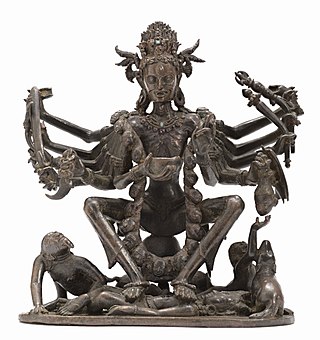
Chamunda, also known as Chamundeshwari, Chamundi or Charchika, is a fearsome form of Chandi, the Hindu mother goddess, Mahadevi and is one of the seven Matrikas.
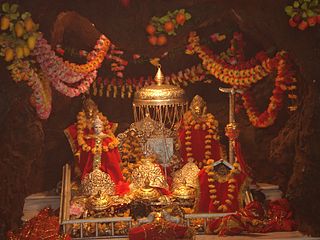
Vaishno Devi is a manifestation of the Hindu mother goddess Durga in some beliefs while in some beliefs she is a manifestation of goddess Lakshmi. Vaishno Devi is worshipped as a combined avatar of the goddesses Mahakali, Mahalakshmi, and Mahasarasvati.

Mahalakshmi Temple is an important Hindu temple dedicated to Goddess Mahalakshmi, who resides here as Supreme Mother Mahalakshmi and is worshipped by locals as Ambabai. Goddess Mahalakshmi is the consort of Lord Vishnu and it is customary among Hindus to visit Tirumala Venkateswara Temple, Kolhapur Mahalakshmi Temple and Padmavathi Temple as a yatra (pilgrimage). It is believed that visiting these temples as a pilgrimage helps achieve moksha (salvation).

Kamakhya, a mother goddess, is a Shakta Tantric deity; considered to be the embodiment of Kama (desire), she is regarded as the goddess of desire. Her abode–Kamakhya Temple is located in the Kamarupa region of Assam, India. Originally a Kirata goddess, Residing on Nilachal hills across the banks of the Brahmaputra River, west of Guwahati in the 10th/11th century Temple rebuilt in 1565 CE, she is worshiped in a non-iconic and un-anthropomorphic form of stone shaped like yoni fed by a perennial stream. The temple is primary amongst the 51 Shakti Pithas, and is one of the most important Shakta temples.

The Shakta pithas, Shakti pithas or Sati pithas are significant shrines and pilgrimage destinations in Shaktism, the mother goddess denomination in Hinduism. The shrines are dedicated to various forms of Adi Shakti. Various Puranas such as Srimad Devi Bhagavatam state the existence of a varying number of 51, 52, 64 and 108 Shakta pithas of which 18 are named as Astadasha Maha (major) in medieval Hindu texts.

The ChottanikkaraDevi Temple is a temple dedicated to the Hindu mother goddess Bhagavati Lakshmi. She is believed to be residing in Chottanikkara (Mahalakshmi) along with her Husband Maha Vishnu. The main deity is also considered as Lakshmi Narayana according to the temple legend. The temple is Classified one among the 108 Abhimana Kshethram of Vaishnavate tradition. The temple is located at Chottanikkara, a southern suburb of the city of Kochi in Ernakulam district, in the state of Kerala, India and is one of the most popular temples in the state.

Kollur Mookambika Temple is located at Kollur in Byndoor Taluk of Udupi District in the state of Karnataka, India. It is a Hindu temple dedicated to the mother goddess Mookambika.
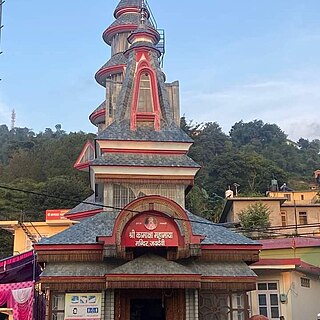
Jaidevi is a small village in Mandi District in Himachal Pradesh. It is situated 13 km off the National Highway that connects Chandigarh and Manali, NH-21. It is also en route to Karsog which is a small but important town of Mandi District.

The Vishalakshi Temple, also known as Vishalakshi Gauri Mandir and Vishalakshi Amman Kovil. It is one of the famous Hindu temple at Varanasi. Dedicated to the goddess Vishalakshi. It was Built and Maintained by Nattukottai Nagarathar a mercantile community from Tamil Nadu
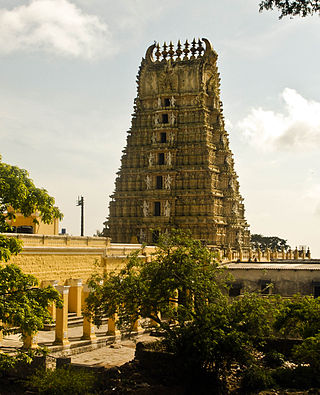
The Chamundeshwari Temple is a Hindu temple located on the top of Chamundi Hills about 13 km from the palace city of Mysuru in the state of Karnataka in India. The temple was named after Chamundeshwari or, the fierce form of Shakti, a tutelary deity held in reverence for centuries by the Maharaja of Mysuru.
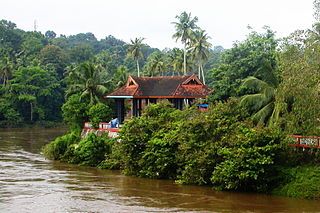
Thazhoor Bhagavathy Kshetram is a 300-year-old Hindu temple on the banks of the Achankovil river in Vazhamuttom, Pathanamthitta District in Kerala. The Devi (goddess) is the main deity here. The centuries-old temple was fully reconstructed in 2020.

Panayannarkavu is a small village In Thiruvalla Sub-District on Parumala Island in the Pamba River in Thiruvalla taluk of Pathanamthitta district in Kerala, India. The village is known for the presence of the Parumala Valiya Panayannarkavu Devi Temple, of which Saptha matha is the presiding power. There is also a temple of Siva on the premises. Panayannarkavu is 3 km (1.9 mi) from Mannar, a village known for its bell-metal lamps and vessels. Until recently, esoteric tantric rituals were conducted in this Saktheya temple.

Bhuvaneshvari is a Hindu goddess. She is the fourth amongst the ten Mahavidya goddesses in Shaktism, and one of the highest aspects of Mahadevi. She is identified as Adi Parashakti in the Devi Bhagavata Purana.

Chandi Devi Temple, Haridwar is a Hindu temple dedicated to Goddess Chandi Devi in the holy city of Haridwar in the Uttarakhand state of India. The temple is situated atop the Neel Parvat on the Eastern summit of the Sivalik Hills, the southernmost mountain chain of the Himalayas. Chandi Devi Temple was built in 1929 by Suchat Singh in his reign as the King of Kashmir. However, the main murti of Chandi Devi at the temple is said to have been installed in the 8th century by Adi Shankaracharya, one of the greatest priests of Hindu religion. The temple also known as Neel Parvat Teerth is one of the Panch Tirth located within Haridwar.

Mumba Devi Temple is a Hindu temple in Mumbai, Maharashtra, India dedicated to the goddess Mumbā, the local incarnation of the Devi. Mumba Devi is the goddess of the city of Mumbai. The name Mumbai is derived from Mumba Devi. While Hindu sects devoted to the goddess Mumbadevi are attested to as far back as the 15th century, it is said that the temple was built in 1675 near the main landing site of the former Bori Bunder creek against the north wall of the English Fort Saint George by a Hindu woman also named Mumba.

Yogamaya is a Hindu goddess who serves as the personification of Vishnu's powers of illusion. In Vaishnava tradition, she is accorded the epithet Narayani—"the sister of Narayana (Vishnu)"—and is regarded as the benevolent aspect of the goddess Durga.

The MajorVellayani Devi Temple is a highly revered shrine in Kerala, India, dedicated to goddess Bhadrakali. The shrine is situated in Vellayani 1.5 km west of Vellayani junction, 12 km southeast of Thiruvananthapuram on the eastern bank of Vellayani Lake. The temple is under the management of Travancore Devaswom Board. The temple structure has a bronze roof with traditional art work and carries Dravidian architecture. The temple has eastern and northern towers called Gopurams with statues of different Gods sculptured in them. The Gopurams function as gateways through the walls that surround the temple complex.

Suket State was one of the Princely states of India during the period of the British Raj. The capital of the state was Pangna. Its last ruler signed the accession to the Indian Union on 15 April 1948. Formerly it belonged to the States of the Punjab Hills and currently, it is part of the Indian state of Himachal Pradesh. The present-day Mandi district was formed with the merger of the two princely states of Mandi and Suket.

The Nateshwori Temple is a Hindu temple of Devi Vagawoti located in the Sudurpaschim province of Nepal Triveni-07 Bajura. This temple is one of the sacred temples of Hindu faith.

Shri Kamaksha Temple Jaidevi, also known as the Kul Devi of the Suket royal family and the Raj-Rajeshwari and Adhisthatri Devi of the Suket principality, is a historic Hindu temple surrounded by mountains in a natural setting.






















